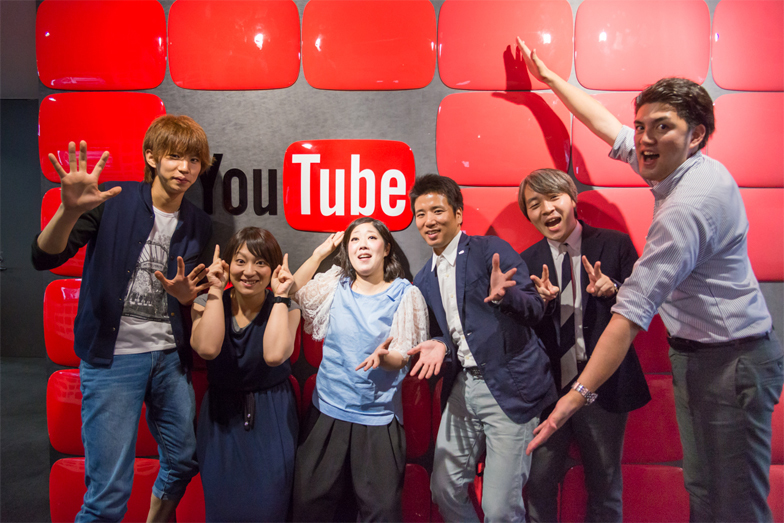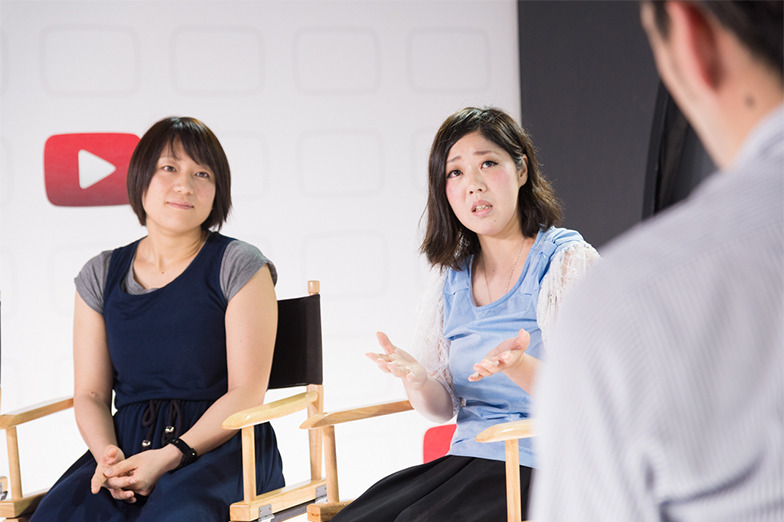How I Became a YouTuber
Ikegami: Today, I want to explore what's happening on YouTube right now through our discussions. First, could you both—Hajime Shacho and Nippon Elektel Rengou—share how you started posting videos on YouTube?
Hajime Shacho (Hajime): I'm currently a fourth-year university student. When I first started, I was just having fun doing silly things with my club friends and close circle. But at some point, that in-group appeal started feeling unsatisfying. I vaguely thought, "If I'm going to do something, I want to do something bigger."
I thought YouTube was great because anyone worldwide could watch videos instantly, without needing to log in, just casually. Also, since I watched a lot of YouTube videos myself, I thought I could create content from a viewer's perspective that people would relate to.
Ikegami: What kind of content did you start with?
Hajime: A classic experiment—what happens when you drop a ramune candy into a carbonated drink. But it only got 13 views at first. It felt like I was the only one watching (laughs).
Ikegami: What did you do to get more people to watch after that?
Hajime: Well, if no one watches, it's pointless, so I decided to do things that would surprise viewers more. For example, I bought out all the bread at the convenience store where I was working part-time at the time. I did things people probably wouldn't do themselves, but I thought they'd want to see. I figured if I wanted to try something, viewers would want to see it too. Lately, I tried riding a unicycle made by connecting 100 unicycles together... (laughs).
Ikegami: In the case of the Japan Elektel Union, you started posting YouTube videos while already active as comedians. This is your third year now. Could you tell us about the initial motivation and the differences compared to other platforms like TV or stage performances?
Japan Elektel Union (hereafter Elektel): We create a lot of comedy sketches, but TV and stage performances alone limit where we can present them. With stage shows, the number of seats limits the audience, and only those who can come see us. When we perform in Tokyo, people living far away or those unable to attend due to work can't see us. With YouTube, people can watch whenever they want. Also, unlike stage performances, we can create material that emphasizes details through editing and camera work—like a scratch on a fingertip or a mole.
On the other hand, with TV—and we recognize this is important—there's the involvement of "others," like the program producers. To be more specific, our material doesn't prioritize punchlines. However, TV has a kind of "format" designed to make viewers feel comfortable watching the show, so having a clear beginning, development, twist, and conclusion—including a punchline—is crucial. We get it completely; when we watch other comedians' material on TV without a punchline, we think, "Huh?"
We also often get requests to explain things because they don't get across to viewers. But we place our emphasis on conveying content without relying on language, so we really dislike verbal explanations. The reason we obsess over details in our outfits and wear extreme makeup is precisely to cut down on the need for words explaining the situation.
For our sketches, if the content itself conveys what we want to express, it's fine to fade out without a punchline. Doing that on YouTube gets no complaints, and since we manage the channel, it doesn't bother anyone. In that sense, it was the optimal way to deliver our work to the audience.
Also, back when we weren't well-known, I remember posting videos on YouTube as our calling card, saying, "This is the kind of stuff we do."
Creating Work in the Social Media Era
Ikegami: On YouTube, you get all kinds of direct comments. How do you incorporate those into your work?
Elektel: We deliberately subvert expectations to meet them. We think surprising viewers with "Oh, they went there!" or "That was a pleasant surprise" creates impact.
On our YouTube channel " Kanden Parallel," we present an image like a talent agency with many artists, preparing gags for over 100 different characters. Among them is "Grandma Minori." This grandmother gradually loses her energy with each gag episode, leading viewers to comment things like, "Grandma Minori looks unwell, are you okay? Please don't die!" So we decided to have her suddenly disappear one day, creating a development that evokes death.
Ikegami: I see, so that's how you respond. If you were meeting viewer expectations, you might have had the grandmother get better, but you deliberately took it in the opposite direction. That's definitely a reaction to the viewers too. What about Haji-sha-cho?
Hajime: I actually respond to comments quite a bit. If someone says "That was fun," I'll say "Thanks." If it's something like "This was boring," I'll say "Sorry. Please check out my other videos." I communicate through comments. However, when it comes to creating content, I don't fulfill every request. I judge based on what I want to express. It's exactly like the phrase "Live by doing what you love." On YouTube, enjoying myself is also important, so I post content I want to do, even if it's not requested.
Ikegami: Beyond direct interaction with viewers, could you tell us about the appeal of YouTube as a platform, Mr. Hasegawa?
Hasegawa: First, the most obvious appeal of online video, not just YouTube, is the freedom from time and location constraints.
Creatively, the lack of constraints also allows creators to experiment widely. As Japan Elektel Union mentioned, they can trial over 100 different ideas and characters, nurturing them while gauging viewer reactions. Both groups deeply understand this unique appeal of online video and build their content accordingly. This might be another key to their popularity.
Furthermore, YouTube continuously develops new technologies to empower creators to constantly explore fresh visual expressions. For instance, starting this June, we enabled the upload and sharing of ultra-high-definition "8K" videos. This allows videos to be shared at approximately 16 times the resolution of terrestrial digital broadcasts. Additionally, as Hajime Shacho has already been utilizing, uploading and viewing 360-degree videos is also possible. Of course, beyond the technology itself, I believe YouTube's appeal also lies in the many creators worldwide who are challenging themselves daily by utilizing these tools.
How do web videos go viral?
Ikegami: As a platform, we continuously strive to cultivate an environment where creativity can flourish. On YouTube, what kind of content are creators providing, and what resonates with audiences? How about Japan Elektel Union?
Elektel: We have a character called "Semi-chan," who's kind of dissing YouTubers. She does product reviews, but she's all over the place, with this so-called "middle school syndrome" vibe (laughs). We're YouTubers ourselves, so we enjoy playing this lovable character. But TV rejected it, saying it wouldn't resonate with viewers. Yet when we actually did it on "Kanden Parallel," it ranked top in character popularity polls. This kind of material wouldn't see the light of day anywhere but YouTube.
Higashihata: TV and YouTube operate under different fundamental rules, right? TV demands content that appeals to a broad audience, while YouTube prioritizes creating content that deeply resonates with individual viewers' specific tastes. And that's how it ends up spreading widely, I suppose.
Hasegawa: Exactly. In terms of hitting diverse viewer preferences, consistently uploading a high volume of videos is a common trait among successful creators. These two groups post videos almost daily. Watching videos every day creates a sense of familiarity, almost like meeting them daily. This closeness and sense of proximity is one reason many viewers get hooked on YouTubers' content.
Ikegami: Do you consciously aim for daily updates?
Hajime: Yeah, we update daily unless we're busy with university commitments or something.
Elektel: Posting daily is important, but of course, doing it every day means you run out of ideas. But what we end up putting out when we're stuck often reveals our true essence or what we really wanted to do. So, surprisingly, the ideas that come out after struggling tend to get a good response. For example, our character "Takasu Kuriko," based on Dr. Katsuya Takasu of Takasu Clinic, has an unnaturally perfect face created with makeup and only says "Yes." This also came out when we were stuck for ideas. Dr. Takasu, who inspired the character, reacted to it via Twitter, and it's now developed to the point where we're making collaboration videos (laughs).
Ikegami: So even on a platform where frequency and such are flexible, deliberately imposing constraints on yourself can actually improve the quality of your output.
So far, we've heard from two creators—Hajime Shacho and Nihon Elekiter Renmei—primarily from a creator's perspective about the unique aspects of creating online videos, like those on YouTube, and communicating with viewers. Next time, we'll delve into YouTube from a corporate perspective, exploring its role in marketing activities.
※Part 2: "What Makes a Web Video Go Viral, According to Advertising Professionals"
※Part 3: "How YouTubers Reveal the Secrets to Being Loved by Fans"













